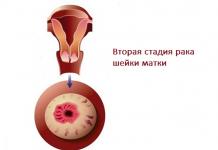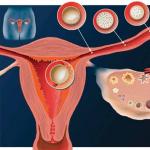Allocations accompany the life of a woman regularly. It does not always mean that this is a deviation or disease of the organs of the reproductive system. The situation is different if discharge occurs during early pregnancy. Such secretions can be of different colors: transparent, white, brown, dark red. Which of these secretions are a cause for alarm, and which are the physiological norm?
During pregnancy, the female body undergoes a restructuring under the influence of physiological processes and the hormone progesterone. The appearance of secretions of light shades at the beginning of pregnancy is considered the norm. In some embodiments, the discharge may be bloody, especially in the first weeks of pregnancy. This can happen on days when menstruation came before pregnancy. A normal secret when carrying a fetus may be completely absent.
The main reason for the occurrence of discharge in the first trimester is hormonal changes in the female body:
- Transparent discharges are considered the safest.
- Slightly brownish discharge in a small amount (daub) may be on the expected days of menstruation in the first month of pregnancy. If you experience aching pain in the lower back and lower abdomen, it is recommended to consult a doctor.
- If a woman notices brown discharge in herself, then this may indicate a threat of termination of pregnancy. In some situations, it is accompanied by aching or severe pain in the lower abdomen.
- Bloody discharge, similar to that of menstruation, is considered dangerous: an ectopic pregnancy or placental abruption can be considered its causes.
The impact of progesterone
Opaque creamy discharge in the second week is considered the result of the active production of progesterone - the key pregnancy hormone. Directly under its influence, a change in vaginal discharge occurs. An increased concentration of progesterone creates positive conditions for a good fixation of the embryo in the uterine endometrium. Attachment occurs approximately 8-10 days after conception. For this reason, white and thick discharge in women can be an indicator of pregnancy.
The vaginal secret in the first weeks of waiting for a child is able to come out with a small amount of bloody streaks, and may also have a pinkish or brownish color. They arise directly at the moment when the embryo is attached to the endometrium of the uterus. In this case, damage to the upper blood vessels can often occur, which provokes a small release of blood. The volume of secretions is very small, and the manifestation itself is short-lived. Such discharge in the first days of pregnancy is completely safe. If in doubt, it would be better to consult a doctor.

Mucus plug formation
Excessive discharge in the first weeks of pregnancy, similar to raw egg white, is not uncommon. Their reason is quite simple. At about the 3rd week of pregnancy, the development and formation of a mucous plug occurs, which reliably protects the internal cavity of the uterus throughout pregnancy, and, consequently, the child itself from the penetration of various pathogenic substances, infectious agents. For this reason, in pregnant women at this time, the volume of secreted transparent mucus increases. Such discharge in the first 4 weeks of pregnancy is completely natural.
Hormonal fluctuations
During the period of bearing a child, significant transformations are made in the body of a woman. Initially, there is a change in the female hormonal background. In certain situations, such a hormonal restructuring occurs with a certain delay, since each organism is individual. There may be options when a woman during pregnancy during the period of potential menstruation has discharge with blood impurities on her underwear. If such secretion is not accompanied by painful spasms and deterioration in health, they pass on their own and again change to ordinary leucorrhoea, then there is no reason for worries. As a rule, during pregnancy there is an increase in the amount of whiteness from the usual state and this is the norm.
Allergic reaction
During the period of bearing a child, the susceptibility of pregnant women increases significantly. That is why allergies in the form of irritation and itching can cause even the usual means that did not previously cause a negative response from the body. Intimate hygiene gel, powder, synthetic materials - all this can cause profuse liquid leucorrhoea, which is accompanied by itching and irritation. Such discharge at the 11th week of pregnancy can be provoked, most likely, directly by this cause. Initially, it is necessary to try to eliminate the influence of the allergen. Sometimes this is enough to stop such discharges.
Transparent shade, small volume, lack of aroma is the normal state of secretion of the genital organs during pregnancy. Mucus secretions create a mucus plug, which means that the fertilized egg has successfully established itself in the uterus. The process is slow, so white, abundant or clear discharge will accompany the expectant mother throughout the entire pregnancy.
Abnormal discharge in early pregnancy with a photo
Knowing which discharge in the early stages of pregnancy is considered a deviation from the normal will help a pregnant woman, if necessary, to orient herself in time and consult a doctor, which will help save the pregnancy and her life.
What should alert a woman in a position when discharge occurs:
- The presence of pain and deterioration of well-being;
- Prolonged discharge;
- The consistency of the secret;
- Quantity;
- The shade of highlights.
To determine what shade of discharge occurred at the 10th week of pregnancy (or any other week), you need to use daily pads.
Red spotting
Such discharge is a dangerous sign of a violation. Often, the causes of such discharges are considered dangerous conditions such as:
- Threat of interruption. Bloody discharge of a scarlet color, pulling pain in the lower abdomen, pain in the lower back or sacrum. A positive outcome in such a situation mainly depends on timely access to a medical institution. It is better to call emergency services and wait for her in the supine position.
- Erosion, polyps, cervical cancer. Bleeding is possible after sexual contact, examination by a specialist.
- bubble skid- violation of the formation of the fetal egg. The danger of this condition is profuse bleeding and the likelihood of cancer formation.

The real cause of such secretions can only be determined by a specialist with the help of ultrasound, gynecological examination, blood test for the compliance of the hCG hormone with the obstetric gestational age.
Smearing brown discharge
Such discharges can be signs of dangerous violations:

yellow discharge
The prerequisites for the appearance of yellowish discharge from the vagina are:
- Inflammation of the genitals. It can cause miscarriage or infection of the fetus. To stop this process, proper treatment is prescribed.
- Sexual infections (often chlamydia, ureaplasma). These infections can cause miscarriage. For this reason, it is important to determine effective and timely therapy. However, it is forbidden to engage in self-medication, since the means of treatment must be selected by the doctor, taking into account the onset of pregnancy. Such secretions always have an unpleasant odor.
Green discharge
Trichomonas is considered the cause of greenish, often even frothy discharge in early pregnancy. The disease that they provoke is called trichomoniasis. In addition to discharge, the signs of this condition include itching, burning, pain in the genitals. Trichomoniasis is quite dangerous during pregnancy, as it can provoke a miscarriage. And only a specialist can determine further therapy, since with self-therapy there is a high probability of using funds that are toxic to the child.
White discharge
Often at the beginning of pregnancy, many may encounter candidiasis. Her expressions: profuse curdled discharge, sour aroma, itching, irritation. Often the cause of thrush is considered physiological immunodeficiency. It is not necessary to self-medicate, since it is forbidden to use the main remedies for candidiasis during pregnancy due to their negative effect on the fetus.
If any of the above pathological types of discharge occurs, you should immediately contact a specialist. If the creamy discharge is irregular, take a picture of the pad before contacting the gynecologist so that the doctor understands exactly what it is about.
Vaginal secretion yellow
There are two options for the appearance of rich yellow discharge during pregnancy in the early stages:
- Inflammatory process in the genitals;
- Reproduction of infection (ureaplasmosis, chlamydia, gardenelosis).
 In parallel with this, a woman may experience pain in the abdomen and in the sacrum. Itching and irritation may also be present in some variants. Such secretions in the first trimester of pregnancy can be dangerous, because they can cause spontaneous abortion, slow down the development of the child and infection in utero, and subsequently lead to premature birth.
In parallel with this, a woman may experience pain in the abdomen and in the sacrum. Itching and irritation may also be present in some variants. Such secretions in the first trimester of pregnancy can be dangerous, because they can cause spontaneous abortion, slow down the development of the child and infection in utero, and subsequently lead to premature birth.
In addition to a change in the color of the discharge, a woman may notice an increase in temperature and pain in her lower abdomen. Such changes are caused by diseases that are sexually transmitted. However, this does not mean at all that the pregnant woman was infected during the period of bearing the child. Most likely, the infection was picked up earlier, but since the immune forces are weakened, it intensified and made itself felt. It also poses a threat to pregnancy, so you need to see a doctor.
Brown discharge early
- Frozen pregnancy
In certain situations, brown discharge may indicate a missed pregnancy. If a woman initially had all the signs of a pregnant condition, and then they all stopped abruptly, plus brown discharge appeared on the linen, then it is likely that the fetus died inside the womb. Gradual exfoliation from the uterine walls of the fetus causes the appearance of brown discharge. In order to dispel your feelings and doubts, it is worth undergoing an examination. The most reliable will be an ultrasound examination, which will show that the embryo does not have a heartbeat.
- Cervical erosion
Indeed, erosion can cause brown discharge, which is explained by mechanical damage to the surface that is affected by the disease. Such discharge can be traced, for example, after examination on a gynecological chair. Erosion therapy is not considered during pregnancy, it will have to be postponed until delivery. Detailed details about the treatment of erosion after childbirth should be discussed with the doctor.
Dark discharge during pregnancy
Allocations at the 6th week of pregnancy (as well as any other week of bearing a child), accompanied by a dark shade and supplemented by acute pain and general weakness, do not belong to normal and natural phenomena. Similar symptoms are characteristic of an ectopic pregnancy, when the embryo is attached not in the uterine cavity, but, for example, in the tube, abdominal cavity or ovary. Such a violation can be quite dangerous for the well-being and life of a woman, since as the embryo grows, the possibility of rupture of the organ and the appearance of heavy bleeding increases.

Green colour
The appearance of green discharge (pus) can be a symptom of diseases such as gonorrhea or trichomoniasis. These sexual diseases can provoke spontaneous abortion. Signs of this condition:
- Burning;
- Swelling of the labia;
- Spots of pus;
- Bad smell.
If such signs appear during pregnancy, it is necessary to consult a specialist as soon as possible and carry out an appropriate examination and therapy.
White flakes in vaginal secretion
Such discharge at the 11th week of pregnancy appears with the same frequency as, for example, at the fifth week of pregnancy or at the thirtieth. Thrush can appear at any week of pregnancy. This stage is characterized by a certain decrease in the body's defenses, which is why quite often such an unpleasant disease as thrush is formed.
At first, the discharge looks like white flakes or cottage cheese grains, which are easily separated from each other. As the disease progresses, the flakes turn into gray films, which, when separated from the mucosa, leave insignificant wounds. Discomfort increases significantly in this case. The disease is accompanied by irritation, itching, swelling, hyperemia of the external genital organs, and a characteristic sour aroma appears.

Such white discharge during early pregnancy does not pose a danger to the fetus, but brings discomfort to the expectant mother. For this reason, it is important to carry out antifungal therapy, which the doctor must prescribe. Often, topical agents are used during pregnancy.
White flakes in the vaginal secret from Utrozhestan suppositories
Utrozhestan is a synthetic analogue of the pregnancy hormone - progesterone. This hormone is a progestogen, which is formed in the corpus luteum after ovulation and is responsible for the development of the secretory endometrium.
The appearance of white discharge from Utrozhestan candles must be divided. Thus, when using the drug intravaginally, white discharge may simply be the contents of the capsule. If the woman correctly introduced the drug, and he managed to dissolve (after the introduction of the capsule, you need to be in a horizontal position for about an hour), then there is nothing to worry about.
No need to try to wash the remnants of the drug from the vagina, while it is forbidden to douche to clean the remnants. Excessive hygiene in this case can be harmful - wash the active ingredient of the drug and prevent it from showing the proper effect. It can also provoke the formation of vaginal dysbacteriosis.
If Utrozhestan is taken orally, then the occurrence of leucorrhoea may indicate the formation of a fungal infection. You need to carefully monitor your own well-being and if itching, burning, redness of the labia occurs, you need to contact a specialist to exclude or treat an infectious disease.
When using Utrozhestan, white discharge can indicate that the woman is not sufficiently in the supine position to absorb the drug. Recall that you need to lie down preferably for about an hour.
Treatment of discharge during early pregnancy
Given certain conditions that caused the occurrence of specific secretions in the early stages, various therapeutic measures are applied. Below we present them in a small scheme:
| Diagnosis | Measures used |
|
Placental abruption |
Hospitalization in a medical institution, the implementation of conservation and hormonal treatment. |
|
Threat of spontaneous abortion |
Hospitalization in an educational institution, the implementation of conservation and hormonal treatment (the use of hormonal drugs, adhering to a half-bed regimen). Taking hemostatic drugs (if necessary). |
|
Cervical erosion |
The implementation of drug therapy, the exclusion of the cauterization procedure. |
|
Frozen pregnancy |
Hospitalization in a medical institution, use of medical abortion, mini-abortion, vacuum, artificial delivery or curettage. |
|
Ectopic pregnancy |
Hospitalization, surgical treatment. |
In addition to a quick visit to the doctor, a woman who has tracked uncharacteristic discharge in herself is recommended to maintain complete control.
Pregnancy is not only a long-awaited miracle, but also a completely new and unexplored period in a woman's life. Too many changes at this time going on in her body. This also applies to the genitals.
The first trimester is considered the most difficult period of pregnancy, especially the first weeks, when the embryo is fixed in the endometrium, and organs such as the placenta and amniotic sac have not yet been formed. It is at this stage that you need to be especially attentive to your body.
Are there discharges in the early stages of pregnancy? Allocations accompany a woman throughout her life, why should they be absent during pregnancy? Moreover, the nature of the discharge in early pregnancy may change before the delay. Part of the discharge is a variant of the norm, some is a non-dangerous deviation from the norm, but some still indicate serious diseases and pathologies, so it makes sense to discuss any changes in the discharge with a doctor. But you should not be nervous ahead of time, a large proportion of the problems associated with secretions are easily solved.
The expectant mother does not need any extra stress. Sometimes, faced with incomprehensible secretions, young mothers panic, begin to get nervous and look for a solution to the problem. And after a visit to the doctor, it turns out that there is simply no reason for concern, and the woman tormented herself and others in vain.
Discharge at an early stage of pregnancy is most often the norm. Firstly, under the influence of progesterone, the natural secretion of the vagina increases: whitish or transparent discharge, sometimes with a slight yellowish tint. The purpose of these secretions is to moisturize the mucous membranes of the vagina, and without them, a woman will feel severe discomfort.
In addition, immediately after conception and attachment of the embryo to the wall of the uterus, mucus begins to be produced, which forms a mucous plug. Naturally, some of this mucus may come out of the vagina. Such mucous, transparent, a bit like egg white, secretions are also normal options.
In general, normal discharge in early pregnancy can be very diverse in both color and consistency, most often there is a clear and white discharge in early pregnancy.
Most importantly, they are united by the fact that they do not cause any inconvenience to the woman. Except, perhaps, natural anxiety due to sudden changes. If the discharge has a neutral smell or it is absent at all, the woman does not feel pain, itching or burning, then there is nothing to worry about. However, going to the doctor for your own peace of mind is not superfluous.
Pathological discharge in the early stages of pregnancy
Brown spotting during pregnancy
Smearing brown or beige discharge during early pregnancy, they can be both completely harmless and indicate serious problems in the body of a pregnant woman. In any case, having found brownish marks on your underwear, you must first contact the doctor and arrange a visit. Still, in most cases, they are symptoms of severe pathologies.
So, the cause of bloody brown discharge in early pregnancy can be detachment of the ovum accompanied by rupture of blood vessels. This pathology requires prompt medical intervention and preservation of pregnancy.
In addition, such discharges may indicate ectopic pregnancy, that is, about a situation where the embryo is attached not inside the uterus, but inside the fallopian tubes and completely outside the reproductive system. Spotting discharge can turn into scanty bleeding, and is also accompanied by severe pain in the lower abdomen.
This condition threatens not only the woman's reproductive ability, but also her life. Unfortunately, if the diagnosis of an ectopic pregnancy is confirmed, it will have to be eliminated.
In some cases, spotting may make itself felt erosion of the uterus. Erosion is an inflammation of the epithelium of the uterus, accompanied by the formation of small wounds and ulcers. Many talk about a direct connection between cervical erosion and a cancerous tumor. In fact, erosion itself has no connection with oncology, however, if the treatment of this problem is delayed, the risk of developing a cancerous tumor increases.
As a rule, cervical erosion is asymptomatic. However, in some cases, small spotting may occur, for example, after violent sex, or after examination by a gynecologist, in general, if the injured cervix is disturbed.
Usually, cervical erosion is treated by cauterization with electricity. However, before childbirth, such a procedure is not recommended, as this will complicate the process of childbirth. During pregnancy resort to medical treatment.
Spotting spotting in early pregnancy may indicate a threatened miscarriage, but more on that later.
Profuse bleeding
Even more fear is caused by abundant spotting in pregnant women in the early stages. It is understandable, everyone has long known that bleeding during pregnancy is one of the most alarming symptoms. The main thing is not to panic, but to take immediate action: get to the hospital on your own, or, much better, call an ambulance and lie down to wait for the doctors to arrive.

What can testify heavy bleeding during early pregnancy? Most often, this indicates a real threat of miscarriage, as a rule, bleeding in this case is accompanied by a pulling pain in the lower abdomen.
It is very important to take action as soon as possible to maintain the pregnancy. However, you absolutely cannot do this on your own. All procedures are only prescribed and under the supervision of a doctor.
To confirm the diagnosis, doctors prescribe a series of studies, including ultrasound and blood and urine tests for hCG. A decrease in the level of this hormone can indicate serious problems.
Treatment can take place both on an outpatient basis and inpatient. The method and method of treatment is determined depending on the severity of the situation. The main thing in these circumstances for a woman is not to worry and not to postpone a visit to the doctor. According to statistics, in more than half of cases, pregnancy with the threat of miscarriage can be saved, subject to timely treatment.
It is much sadder if the bleeding turns out to be a symptom of a rare pathology, which is called " bubble skid". This name hides the result of a deviation in the process of fertilization of the egg. As a result of this deviation, the fertilized egg does not have maternal DNA, only duplicated paternal DNA.
Naturally, the development of the embryo in this case does not occur, as well as normal placental tissue. The pathological placenta in this case develops in the form of many cysts on the wall of the uterus. On ultrasound, this pathology looks like bunches of grapes. A cystic drift requires urgent surgical intervention.
Another cause of bleeding is more common in women who have undergone in vitro fertilization (IVF), although it also occurs in some cases of natural multiple pregnancies. Sometimes one or more embryos are rejected and come out naturally. In this case, it is customary to talk about vanishing twin.
However, bleeding is not always a warning sign. In some cases, it is caused by completely harmless processes, which, although they are deviations from the norm, do not entail any consequences.
If the bleeding is not too profuse and stops quickly, it may be a harmless consequence of the process. attachment of the embryo to the wall of the uterus. The endometrium is softened by this time, and the number of blood vessels in it is somewhat increased. Damage to one of them can cause bleeding.
There are no other threatening symptoms with this disorder, including the woman does not feel pain. This phenomenon does not pose a danger, but this does not mean that a visit to the doctor can be neglected. Only a doctor can make a diagnosis.
Some disruptions in the hormonal background can lead to the fact that in the early stages of pregnancy, in accordance with the previous menstrual cycle, bleeding similar to menstruation.
By the way, such deviations in some cases prevent women from determining pregnancy in themselves. After all, some of them, especially those who are not yet planning a pregnancy, are guided mainly by their cycle. This bleeding also does not pose a danger to pregnancy.
Thrush in the early stages
Changes in the hormonal background and other changes in the body of a pregnant woman often cause a decrease in immunity. In this regard, in the early stages, pregnant women are faced with thrush, the medical name for this disease is candidiasis. The causative agent is the Candida fungus, which is almost always present in the microflora of the vagina, but does not develop normally. Thrush often begins while taking antibiotics, during other diseases, or during pregnancy.

The symptoms of this disease are known to many women: white or greenish curdled discharge, mild or severe itching, burning in the vaginal area. One of the common problems with thrush is that women are calm about this disease. Especially if you've been sick before.
The percentage of women engaged in self-treatment is large. However, it is impossible to use the same drugs for thrush that are usually prescribed during pregnancy, as they are harmful to the fetus.
Yellow and green discharge
There are also green or yellow discharge in early pregnancy. The color, shade and consistency of these secretions can vary greatly. Patients describe green bubbling discharge, or bright yellow, which, in fact, are accumulations of pus. Most often, such discharges are symptoms of acute infections, in some cases, they even talk about sexually transmitted diseases.
In these cases, additional studies are carried out to clarify the diagnosis, after which treatment is prescribed. In the early stages, infectious and fungal diseases are especially dangerous for the fetus, for the reason that the placenta - the organ that protects the child from external influences - will finally form only by the fourth month, but for now, all the infection from the mother's body can freely enter the blood of the fetus. So the infection needs to be treated urgently.
But here, too, problems arise. Moreover, they are all associated with the same risk of penetration of drugs into the blood of the child. During pregnancy, the selection of medicines is always difficult, but in the early stages it is a particularly difficult task.
The danger of self-treatment or delay in treatment is not even worth talking about. However, I would like to mention those women who refuse to take medication in an effort to protect the child. Their motives are clear, now a lot and often they talk about the dangers of medicines.
Is there a discharge in the early stages of pregnancy - the question is fundamentally wrong. Of course have. Much more important is what kind of allocations take place. It is very important to be attentive to your body, to monitor all, even the smallest, changes in your well-being. And about any alarming symptoms immediately report to the gynecologist.
It is very important that the doctor who observes the pregnant woman is experienced and qualified. In some cases, it makes sense to change the doctor or clarify the diagnosis with another specialist. Although there is not always time for this. In some cases, urgent action needs to be taken.
I like!
Can early pregnancy discharge threaten? Usually, such symptoms greatly frighten a woman who has only recently learned about the long-awaited conception. Is it worth it to be nervous about this phenomenon? This question cannot be answered unequivocally, since discharge can be considered the norm, or it can indicate serious problems. In any case, the discharge in the early stages of pregnancy should be carefully looked at, and at the slightest suspicion of a pathology, you should contact a gynecologist. Pregnancy, especially in the 1st trimester, is a very important period for any woman, and therefore various incomprehensible phenomena should be treated with caution.
Vaginal discharge of various types is a constant "companion" of any woman. The produced mucous mass performs important functions: protection against infections, moisturizing the penis, spontaneous cleansing of the cavity. It is natural that part of it comes out. In its composition, the usual physiological secreted masses contain mucus secreted by the glands of the cervical canal, dead particles of the epithelium and various microscopic organisms (mainly lactic acid bacteria). Another question: how does this phenomenon coincide with the period of pregnancy and how does the composition of the discharge change?
Starting from the process of fertilization, the entire period of pregnancy is characterized by a significant change in hormonal balance. In the early stages (in the 1st trimester), the production of progesterone increases significantly, which reduces the volume of secretions, but makes them thick and opaque. A mucous plug begins to form in the uterine canal to protect the embryo from infection, which cannot but affect the nature of the vaginal discharge.
Throughout the life of a woman (especially during the period of bearing a child), discharge can be considered a special indicator of the state of the female urogenital organs, and the whole organism as a whole. They have their own specific parameters that can tell a lot to a specialist: color, consistency, intensity, frequency, smell. An important condition for a normal process is the absence of any alarming symptoms: itching, pain, burning, inflammatory reactions, irritation of the external genital organs, and a strong odor.
Thus, not all discharges give rise to panic. However, you can not relax; The following manifestations accompanying vaginal discharge in early pregnancy are recognized as the reason for contacting a doctor:
- itching in the perineum;
- the appearance of a pronounced color;
- the occurrence of pain syndrome;
- discomfort and heaviness in the lower abdomen.
Non-dangerous manifestations
Early pregnancy includes several characteristic physiological processes, which are accompanied by corresponding secretions. Within 7-10 days after the birth of a new life, the fetal egg is implanted into the uterine endometrium. During this period, the so-called implantation bleeding is considered quite natural, i.e. bleeding in the area of damage to the uterine wall. There may be traces of blood in the discharge (bloody discharge).
The process of egg introduction proceeds with varying degrees of intensity, which depends on the characteristics of the female body. Accordingly, the color of vaginal discharge may acquire pink or brown (usually light brown) shades. The duration of such a phenomenon is short-term and, as a rule, does not exceed 1.5-2 days. Such signs are quite natural and do not affect the beginning of pregnancy in any way.
Small (smudgey) spotting in the first month of pregnancy may appear on days when menstruation used to pass. So the body removes all previously formed unnecessary accumulations. You can not be afraid if this phenomenon is detected within 1-3 weeks after conception and is not accompanied by pain.
The next characteristic stage is the formation of a mucous protective plug. At this stage, under the influence of progesterone, the mucus becomes thick and loses its transparency. At this time, white thick discharge is the norm. These are sometimes called milk secretions and do not cause any harm.
In addition to physiological processes, in the 1st trimester one cannot discount the fact that the female body becomes more sensitive to external factors. Various secretions can be a reaction to irritants such as hygiene products, linen material, etc. In this case, there may be a clear discharge with itching, but without a strong odor.
Danger of bleeding
In addition to natural physiological processes, vaginal discharge at an early stage of pregnancy can signal the presence of serious pathologies. Spotting is one of the most worrying signs. They can have both direct blood inclusions (clots) and a characteristic shade: red, brown, pink.
The following hazards can be distinguished:
- Risk of miscarriage. The probability of termination of pregnancy at a very early stage is associated with the exfoliation of the fetal egg. In this case, the discharge becomes scarlet or red-brown in color and is accompanied by pain in the lower abdomen with irradiation to the lumbar region. The discharge can be profuse and very painful. Only urgent intensive care prevents spontaneous abortion.
- Uterine pseudo-erosion. Blood in the secretions appears from bleeding in the cervix, which can be provoked by contact exposure: sexual intercourse, douching, gynecological examination.
- Bubble drift. Bleeding is associated with the transformation of chorionic villi into a cyst, which leads to the death of the fetal egg. With such a pathology, urgent measures are needed.
- Bloody (red) discharge is possible when an egg is implanted in a myomatous node, the presence of polyps in the cervical canal, injuries of the abdomen and genital organs, as well as diseases that impair blood clotting.
- Detachment of the chorion. Brown discharge is observed as a result of the formation of a retroplacental hematoma, i.e., the accumulation of blood mass between the uterine wall and the chorion.
- Pregnancy of an ectopic type. Discharge of a brown tint may have a single character or occur periodically.
- Stopped, or non-developing, pregnancy. Brown discharge appears as a result of detachment of the fruiting egg, while the embryo has already died.
Appearance of white discharge
As noted above, white discharge often has a physiological nature associated with the formation of a protective plug. At the same time, such a phenomenon may be a symptom of candidiasis or thrush.
The most common is urogenital candidiasis, which is an infectious fungal disease caused by the fungus Candida. The increased incidence at an early stage of pregnancy is explained by suppression of immunity during fertilization and implantation of the egg, which is a necessary measure for the body, as well as an excess of estrogens, which remove lactic acid bacteria, which normally slow down the development of a fungal pathogen. As a result, the risk of candidiasis in the 1st trimester of pregnancy increases significantly.
The main symptom of the disease is leucorrhoea with specific curdled lumps. The discharge is intense and emits a sharp unpleasant odor with a sour tint. At the same time, itching, burning and redness of the genital organs occur. The treatment of pregnant women is hampered by the relevant restrictions. Most often, vaginal suppositories such as Pimafucin and Hexicon are prescribed.
yellow tint
If yellow discharge is detected in pregnant women at an early stage, then the development of an inflammatory reaction of the ovaries or uterine appendages can be assumed.
Sometimes it is these discharges that become the only manifestation of the pathological process. One of the common diseases is vaginitis. In this case, the discharge has a light yellow tint, and in addition to them, there is itching, burning, an unpleasant odor, as well as pain during urination.
Another culprit for yellow discharge may be an infection that could have penetrated sexually even before conception, but was waiting for favorable conditions. The most characteristic activation of chlamydia, ureaplasma, cytomegalovirus and some other pathogenic bacteria. These pathogens are dangerous because they can lead to miscarriage.
In the early stages of pregnancy, yellowness in the excreted mucus can also be explained by non-pathogenic causes. One option is a slight leakage of urine as a result of a sharp activation of the kidneys and bladder under the influence of elevated levels of progesterone. It is drops of urine that can give a yellowish tinge to mucus. As a prophylaxis for women in such cases, a set of Kegel exercises is recommended, which strengthens the muscular system.
Rarely enough, but dark yellow discharge is recorded due to an allergic reaction. Such reactions can occur on synthetic underwear and hygiene products. To exclude such phenomena in women with a tendency to sensitization of the body, it is recommended to wear only cotton underwear during pregnancy.
Other pathologies
In the presence of some sexually transmitted diseases, the discharge may turn greenish, yellowish green and dirty green. In the early stages of bearing a child, trichomonas are often sharply activated and trichomoniasis develops. This disease provokes colpitis, which is manifested by green secretions with a sharp unpleasant odor. At the same time, the following symptoms are observed: severe itching, pain in the vulva and vagina.
Trichomoniasis is very dangerous for a developing fetus: it increases the risk of spontaneous abortion. Treatment is complicated by the fact that drugs against Trichomonas are toxic to the embryo and their use in the 1st trimester of pregnancy is contraindicated. With this in mind, the best way is to prevent the disease.
Vaginal discharge is a kind of indicator of the state of the female body. By their color, texture and smell, a specialist can make a primary diagnosis. It is important that a pregnant woman consult a doctor in a timely manner when the first warning signs appear. Treatment in the early stages of pregnancy has many limitations, and therefore it is the timeliness of treatment that can save the child, and the health of the woman herself.
Calmly and without fear, you should treat the discharge during pregnancy in the early stages. The increase in the volume of secretion during childbearing is associated with a change in blood circulation in the uterus. The secreted mucus should be clear, viscous and odorless. If the color and texture do not correspond to the norm, there is a possibility of developing serious diseases. Most of them are dangerous, so a woman must correctly assess the changes taking place in the body and understand the difference between normal and pathological whites.
Some diseases during childbearing are secretive, and the only sign of existing problems may be vaginal discharge at the beginning of pregnancy. Transparency and lack of smell are the main indicators of the norm. In cases where the color, volume, structure and nature of the mucus change, consult a doctor.
The help of specialists is also necessary in the absence of discharge during pregnancy in the early stages. The uterus and vaginal mucosa need constant hydration and protection. With insufficient mucus production, this process is disrupted. Infections freely penetrate the genital organs, which negatively affects the development of the fetus.
Physiological
In the first trimester, progesterone affects all processes in the body of a pregnant woman. The active production of this hormone is reflected in the nature and structure of the secreted mucus. It has a curdled consistency, white color and no smell.
The abundance of discharge at the beginning of pregnancy is high, since a thick mucous plug forms in the cervical canal during this period. It is formed in the first month after conception and serves as a protective barrier against the penetration of harmful bacteria and infectious agents throughout pregnancy.
As the influence of progesterone weakens and the activity of the hormone estrogen gradually increases, the mucus thins and acquires a more liquid consistency. The color of the discharge in pregnant women in the early stages is either absent or varies from white to milky. If the phenomena do not cause discomfort and the tests are normal, the woman may not worry about her condition.

Short-term brown or discharge in the first days after conception is also considered a physiological norm. Gynecologists call this condition implantation bleeding. After the fertilized egg is introduced into the wall of the uterus, it deepens in the epithelial cells in order to securely gain a foothold. This is accompanied by microscopic damage to blood vessels. Minor bleeding occurs, which should stop after a few days.
Pathological
Particular attention is required to highlight the first days of pregnancy. The body gets used to the new state and perceives the fetus as a foreign body. Natural mechanisms suppress a woman's immunity, which causes frequent colds and the development of inflammation in the genitals. You can learn about infection by the symptoms characteristic of this condition, such as:
- change in the nature of discharge in the first trimester of pregnancy;
- itching and burning;
- pain during intercourse;
- swelling and redness of the external genitalia.
Some diseases are latent and asymptomatic. A woman can learn about health problems by the changed nature and color of the vaginal secretion. This can happen at any time, so you need to constantly monitor the excreted mucus and inform the doctor about any changes.

White
White discharge during pregnancy is observed at all stages and is rarely pathological. Without smell, color and additional symptoms, they are not dangerous, but in cases where, in parallel with the appearance of flocculent discharge, a woman detects a sour smell and feels itchy in the genitals, medical attention will be required. Most often these are signs of candidiasis and bacterial vaginosis.
An exacerbation of thrush during pregnancy is the body's reaction to a weakened immune system. Pathogenic microflora begins to multiply uncontrollably and leads to candidiasis. Vaginal bacteriosis also develops due to a decrease in immune defense and can be triggered by hormonal disruptions.
Regardless of the causes of the development of the disease, the risk of miscarriage and premature birth increases. In order to avoid complications, it is desirable to undergo an examination and stop the progression of the pathology at the initial stage.
Red
Such secretions are among the most dangerous in early pregnancy, especially when there are lumps and clots in the secret. Such manifestations can be triggered by an ectopic pregnancy, cervical erosion, the presence of a malignant tumor, or the development of a mole. There are a lot of reasons, the most harmless include late menstruation.
The growth of the pregnancy hormone in the body is observed only after the attachment of the fetal egg to the wall of the uterus. This usually happens in the first days after conception. Sometimes the embryo joins the uterine surface at the end of the cycle, and the hormone that suppresses menstruation simply does not have time to develop in sufficient quantities. The woman begins minor and short-term bleeding. For bearing a child, they are not dangerous, but for the sake of your own peace of mind, it is better to tell the doctor about everything and do an ultrasound.

Red discharge is observed in women with fibroids detected before pregnancy and in the presence of cystic formations. Everything related to tumor conditions should be strictly controlled by a doctor.
The most dangerous thing that can happen is the necrosis of the tissues of the neoplasm. In such cases, miscarriage is inevitable. In the later stages, doctors save the baby and mother, but often the uterus is removed after childbirth. There are a lot of examples of a successful outcome of pregnancy with fibroids. If the diagnosis has already been made and pregnancy has occurred, the woman should monitor her health and respond to any manifestations of discomfort and changes in the nature of the secret.
Another cause of red discharge is the exfoliation of the fetal egg. This condition is considered a sign of a threatened miscarriage. In the early stages, the appearance of bloody mucus is accompanied by discomfort in the lower abdomen, in the later stages, the pain is stronger and looks like contractions.
Even with the meager nature of red discharge, a woman needs to seek medical help. With the timely intervention of doctors, the loss of a child can be prevented.
The appearance of bleeding after the 28th week of pregnancy is referred to as prenatal complications. Red discharge can be caused by rejection or malposition of the placenta when the entrance to the cervix is blocked. The abnormal state of the embryonic organ provokes an increase in blood pressure, which leads to the appearance of a red smearing secret.
Brown
In the first month of pregnancy, scanty brown discharge is not dangerous. Often they are observed during the period of implantation and attachment of the fetal egg, as well as in the later stages, when the mucous plug that covers the cervix throughout the pregnancy departs. In other cases, the appearance of brown mucus is attributed to pathological conditions. Sometimes they are accompanied by pain, bad breath, frequent urination and irritation in the genitals. All these are signs of infection and inflammatory processes that have begun in the body.

Unfortunately, very often such discharges are found when it is no longer possible to save the pregnancy. This occurs with the development of a genetic anomaly called "cystic drift", ectopic and missed pregnancy.
Too dark discharge, similar to black, characterizes ectopic and uterine bleeding.
Less dangerous and correctable conditions include brown discharge in early pregnancy, provoked by hormonal disorders and diagnosed cervical erosion. In such cases, doctors help a woman to keep and give birth to a healthy child.
Green or yellow
The most harmless reason for the appearance of yellow can be external irritants. Elementary uncleanliness and non-compliance with intimate hygiene contribute to the multiplication of pathogenic bacteria, which contributes to the formation of yellow-green mucus.
The secretion of this color may indicate an exacerbation of inflammatory processes in the urogenital area. As a rule, mucus has an unpleasant odor and is accompanied by burning and itching in the genitals.
Also, the causes of greenish discharge or are diseases caused by nonspecific bacteria (staphylococci and E. coli), and genital infections (chlamydia, gonorrhea, ureaplasmosis). The symptoms of these pathologies are largely similar. In addition to the atypical secret, women experience itching, pain in the lower abdomen, and problems with urination.
If you find any of these signs, consult your doctor. Complex diseases, accompanied by yellow-green discharge, can provoke a miscarriage at any time, so it is necessary to be treated immediately after the detection of harmful microorganisms.

Cream
Abundant may be a sign of developing thrush, but in most cases, such a secret is associated with the formation of an ectopic pregnancy, when the fetal egg is attached outside the uterus. The abnormal location of the embryo is accompanied by severe pain and requires surgical intervention.
When to see a gynecologist
To determine the color of the discharge, women are advised to use panty liners. All changes will be visible. Always pay attention to the duration, consistency, volume of mucus and the presence of pain.
Any new symptom and deterioration in well-being should alert. Do not wait for everything to work out and try to solve problems on your own. With the development of pathology during the bearing of a child, self-medication is ineffective and unsafe. Many drugs are contraindicated for pregnant women, and folk remedies, if handled ineptly, can only do harm.
The advanced stages of diseases are more difficult to treat, so if you find the first suspicious symptoms and discharge, contact the antenatal clinic or call an ambulance.
Do not postpone a meeting with a gynecologist when you are worried about severe pain, itching, burning and other uncomfortable sensations. The doctor should be aware of such conditions. This will help to establish an accurate diagnosis and start treatment in a timely manner.
Diagnostics
Most of the diseases accompanied by vaginal discharge can be treated. Early diagnosis increases the chances of successfully solving the health problems of the expectant mother and prevents pregnancy loss.
Before starting treatment, the doctor examines the symptoms and prescribes a diagnostic examination, which includes urine and blood tests, ultrasound, and a microflora smear. The number of laboratory tests is determined by the gynecologist. After the cause of the disease is clarified, the specialist determines the type of pathogen, the degree of neglect of the pathology and prescribes the appropriate treatment.
Allocations happen in women all the time. It does not always mean that this is a deviation or disease of the reproductive organs. Another thing is if the secret is released during pregnancy. Discharge during pregnancy in the early stages are of different colors: white, transparent, brown, dark red - which of them mean the onset of the disease, are the result of normal physiological processes, find out further.
Can there be discharge during pregnancy
During the bearing of a child, a woman's body is rebuilt under the influence of physiological processes and the female hormone progesterone. The appearance of a light-colored secret at the beginning of pregnancy is the norm. Sometimes the secret is bloody, especially in the early stages of gestation. This is possible in those days when menstruation came before pregnancy. Normal vaginal discharge during childbearing may be completely absent.
What is discharge during pregnancy
Transparent discharge when carrying a child is a logical consequence of hormonal changes. If you observe a mucous secret that looks like raw chicken protein, this is the norm. It protects the genitals of women and helps the sperm to move faster to the egg. At the time of fertilization, the discharge is thick, opaque, viscous. After conception, a meager mucous secretion appears, which is produced by the vaginal mucosa. During gestation, it can be transparent, white, yellow, red or brown.
Causes
The main reason for the appearance of discharge in the first trimester is the hormonal changes in the body of a woman:
- The safest is a transparent secret.
- A slightly brown secret in a small amount (spotting) occurs on the days of the planned menstruation the first month of pregnancy. With the appearance of aching pain in the lower back and lower abdomen, it is recommended to consult a gynecologist.
- If you observe a brown abundant secret, this may indicate a threatened miscarriage. Sometimes it is accompanied by aching or severe pain in the lower abdomen.
- Bloody secretion, such as during menstruation, is dangerous: it can be caused by an ectopic pregnancy or placental abruption.

What discharge in early pregnancy
According to the vaginal secret, the expectant mother can determine her condition. In the early stages, attention is paid to color, smell, texture or sensation. During the first trimester, a watery, colorless, odorless secretion is normal. However, it is recommended to consult a specialist in the presence of mucus:
- Brown color;
- white curdled discharge;
- yellow, greenish hue (purulent secret).
What are considered normal
Transparent color, small amount, lack of smell is considered the normal state of genital secretions during pregnancy. The mucus forms a mucus plug, which means that the embryo has successfully attached to the cervix. The process drags on slowly, so a white or transparent secret in the early stages will accompany the expectant mother for the entire gestation period.
Pathological discharge
Gynecologists include pathological discharges in pregnant women in the early stages, caused by bacteria or fungi that can harm the baby. These pathogens include candidiasis, which is caused by the reproduction of the Candida fungus. This disease cannot be treated, since the necessary drugs are contraindicated for pregnant women. If itching, burning, a color other than clear or white, accompanied by unpleasant odors (strong or weak), you should consult a doctor to maintain pregnancy.
White
White discharge in early pregnancy in a small amount does not indicate problems. However, if you notice unpleasant symptoms (a bad smell, the consistency of the secret has changed (it has become like cottage cheese), the genitals have turned red, you regularly feel a burning sensation), consult your doctor. Candidiasis can become a threat of deep rupture of the genital tract during childbirth. At the walls of the vagina, the tissues will become loose and lose elasticity, which leads to severe labor activity.

Red
The appearance of a scarlet secret during pregnancy is the most dangerous for a woman. They can be profuse, scanty brownish in color. In case of severe bleeding with severe pain in the lower abdomen, it is recommended to immediately consult a doctor. Such a secret signals an abortion or ectopic pregnancy. Not abundant light brown, brown discharge in the early stages is considered not fatal to the fetus.
The cause of the scarlet secret can be:
- cervical erosion;
- inaccurate douching;
- inaccurate contact gynecological examination;
- cystic skid;
- myoma nodes;
- abdominal trauma;
- polyp of the cervical canal;
- diseases that relate to the blood coagulation system.
Brown
A small secret of a light brown color may be during the attachment of the fetal egg to the uterus. If these are one-time short-term and scanty brown discharge at the beginning of pregnancy, then they do not pose a threat. During this period, a woman may be disturbed by a pulling discomfort in the lower abdomen. Dark brown discharge may be a sign of detachment of the chorion or future placenta.
The periodic or single appearance of a brown secret in the first trimester of pregnancy may be a sign of an ectopic, frozen or non-developing pregnancy, when the embryo dies, and the fetal egg remains in the uterine cavity. Over time, the placenta exfoliates from the walls of the uterus, which is the cause of the appearance of a dark secret in women. If it occurs, it is recommended to consult a doctor.
gray
The secret of gray color stands out in the first stages, has a characteristic odor and is accompanied by a burning sensation in the genitals. This is a signal of the presence of genital infections (vaginitis, trichomoniasis or other diseases). Trichomoniasis is very dangerous for pregnant women, who in this case are subject to urgent hospitalization. Bacterial vaginitis is different. Pregnant girls with this disease find it difficult to bear a child.

Cream
Slight beige or creamy discharge during early pregnancy may indicate an inflammatory disease. In the process of exacerbation of the inflammatory disease, the girl may feel discomfort near the external genitalia, accompanied by the release of milk secretion. The reasons for the appearance may be:
- coli;
- staphylococcus or proteus;
- gonorrhea;
- gardenellosis or trichomoniasis.
Another reason for beige discharge is an insufficient amount of female sex hormones in the blood. The hormone progesterone supports the body during pregnancy, promotes the growth and tone of the uterus, reduces the activity of the immune system in the early stages of embryo development, which is necessary for the body to accept a fertilized egg. In case of bleeding, you should consult a doctor.
Treatment of discharge during early pregnancy
When examined by a gynecologist and after an ultrasound, the doctor can determine not only the timing of pregnancy, but also the problem with the secret. If the discharge in the early stages of pregnancy smells and looks strange, doctors examine the woman and take tests for fungal and vaginal infections. If the diseases are confirmed, the girl will be provided with safe treatment that will not harm either the child or the mother.
Bloody discharge during early pregnancy is treated with medication and bed rest with a special diet. If the treatment of uterine erosion is carried out after the onset of pregnancy, then it is removed using electrocoagulation. However, with the appearance of complications (pathology of the cervix), anti-inflammatory or wound healing drugs are used.
With the threat of miscarriage, the expectant mother is prescribed a course of taking hormonal drugs. Unfortunately, a frozen pregnancy cannot be treated: it ends with a spontaneous abortion. Foamy discharge is treated with effective medications, but not all drugs are suitable for pregnant women. Symptoms of thrush are recommended to be treated with warm baths of herbal decoctions or safe medicines.
Photo of discharge during pregnancy

Video


















